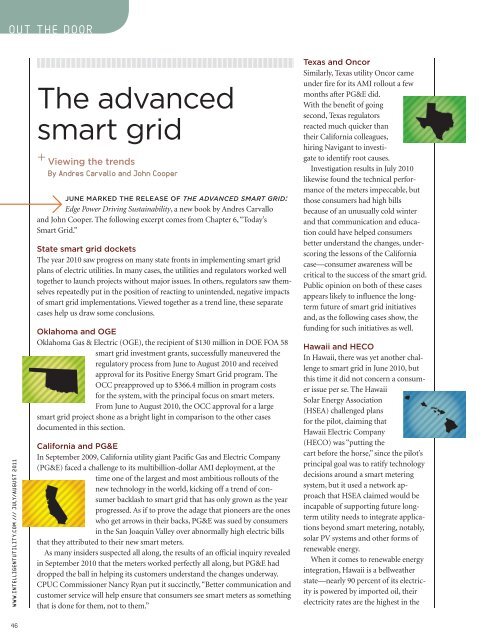FERC vs NERC: A grid control showdown over cyber security
FERC vs NERC: A grid control showdown over cyber security
FERC vs NERC: A grid control showdown over cyber security
Create successful ePaper yourself
Turn your PDF publications into a flip-book with our unique Google optimized e-Paper software.
OUT THE DOOR<br />
WWW.INTELLIGENTUTILITY.COM /// JULY/AUGUST 2011<br />
46<br />
The advanced<br />
smart <strong>grid</strong><br />
+ + Viewing the trends<br />
By Andres Carvallo and John Cooper<br />
JUNE MARKED THE RELEASE OF THE ADVANCED SMART GRID:<br />
Edge Power Driving Sustainability, a new book by Andres Carvallo<br />
and John Cooper. The following excerpt comes from Chapter 6, “Today’s<br />
Smart Grid.”<br />
State smart <strong>grid</strong> dockets<br />
The year 2010 saw progress on many state fronts in implementing smart <strong>grid</strong><br />
plans of electric utilities. In many cases, the utilities and regulators worked well<br />
together to launch projects without major issues. In others, regulators saw themselves<br />
repeatedly put in the position of reacting to unintended, negative impacts<br />
of smart <strong>grid</strong> implementations. Viewed together as a trend line, these separate<br />
cases help us draw some conclusions.<br />
Oklahoma and OGE<br />
Oklahoma Gas & Electric (OGE), the recipient of $130 million in DOE FOA 58<br />
smart <strong>grid</strong> investment grants, successfully maneuvered the<br />
regulatory process from June to August 2010 and received<br />
approval for its Positive Energy Smart Grid program. The<br />
OCC preapproved up to $366.4 million in program costs<br />
for the system, with the principal focus on smart meters.<br />
From June to August 2010, the OCC approval for a large<br />
smart <strong>grid</strong> project shone as a bright light in comparison to the other cases<br />
documented in this section.<br />
California and PG&E<br />
In September 2009, California utility giant Pacific Gas and Electric Company<br />
(PG&E) faced a challenge to its multibillion-dollar AMI deployment, at the<br />
time one of the largest and most ambitious rollouts of the<br />
new technology in the world, kicking off a trend of consumer<br />
backlash to smart <strong>grid</strong> that has only grown as the year<br />
progressed. As if to prove the adage that pioneers are the ones<br />
who get arrows in their backs, PG&E was sued by consumers<br />
in the San Joaquin Valley <strong>over</strong> abnormally high electric bills<br />
that they attributed to their new smart meters.<br />
As many insiders suspected all along, the results of an official inquiry revealed<br />
in September 2010 that the meters worked perfectly all along, but PG&E had<br />
dropped the ball in helping its customers understand the changes underway.<br />
CPUC Commissioner Nancy Ryan put it succinctly, “Better communication and<br />
customer service will help ensure that consumers see smart meters as something<br />
that is done for them, not to them.”<br />
Texas and Oncor<br />
Similarly, Texas utility Oncor came<br />
under fire for its AMI rollout a few<br />
months after PG&E did.<br />
With the benefit of going<br />
second, Texas regulators<br />
reacted much quicker than<br />
their California colleagues,<br />
hiring Navigant to investigate<br />
to identify root causes.<br />
Investigation results in July 2010<br />
likewise found the technical performance<br />
of the meters impeccable, but<br />
those consumers had high bills<br />
because of an unusually cold winter<br />
and that communication and education<br />
could have helped consumers<br />
better understand the changes, underscoring<br />
the lessons of the California<br />
case—consumer awareness will be<br />
critical to the success of the smart <strong>grid</strong>.<br />
Public opinion on both of these cases<br />
appears likely to influence the longterm<br />
future of smart <strong>grid</strong> initiatives<br />
and, as the following cases show, the<br />
funding for such initiatives as well.<br />
Hawaii and HECO<br />
In Hawaii, there was yet another challenge<br />
to smart <strong>grid</strong> in June 2010, but<br />
this time it did not concern a consumer<br />
issue per se. The Hawaii<br />
Solar Energy Association<br />
(HSEA) challenged plans<br />
for the pilot, claiming that<br />
Hawaii Electric Company<br />
(HECO) was “putting the<br />
cart before the horse,” since the pilot’s<br />
principal goal was to ratify technology<br />
decisions around a smart metering<br />
system, but it used a network approach<br />
that HSEA claimed would be<br />
incapable of supporting future longterm<br />
utility needs to integrate applications<br />
beyond smart metering, notably,<br />
solar PV systems and other forms of<br />
renewable energy.<br />
When it comes to renewable energy<br />
integration, Hawaii is a bellweather<br />
state—nearly 90 percent of its electricity<br />
is powered by imported oil, their<br />
electricity rates are the highest in the















![View From the Trenches [PDF]](https://img.yumpu.com/18854438/1/190x252/view-from-the-trenches-pdf.jpg?quality=85)
